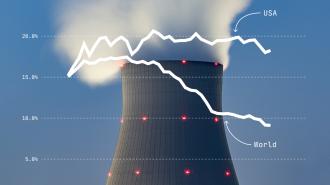Freethink Research is a collaboration with the research team at Nightview Capital. Subscribe to their weekly newsletter, The Nightcrawler, in the form above. Follow Eric and Cam on X.
Nuclear power has a checkered history, producing abundant, reliable, clean energy for decades, but with several major high-profile accidents marring its public image. As artificial intelligence demands unprecedented amounts of energy, nuclear power—long stalled in its growth—could be poised for a comeback. This issue of Freethink Research looks at the state and safety of nuclear fission today, and explores the possibility that nuclear’s future will lie in an entirely new direction, thanks to advances in fusion.
Since 1985, the global share of electricity generated by nuclear power (i.e., fission) has declined on the world stage, while it has largely held steady in the United States. Despite nuclear fission reactors providing vast amounts of electricity with little air pollution or carbon emissions, the industry has not taken share from competing generation technologies.
Why is that? In part, it is because of historical nuclear accidents. The Three Mile Island, Chernobyl, and Fukushima meltdowns caused fear among the public and influenced policy decisions around the world. Despite these headline-making disasters, the actual data indicate many of the negative perceptions of nuclear fission are misplaced.
The risks from nuclear power — even considering its three worst accidents — are incredibly low compared to other electricity sources. Nuclear’s rate of 0.03 deaths per terawatt hour puts it among the safest sources of energy, rivaling solar (0.02) and wind (0.04). And stacked up against legacy generation techniques, like oil and coal, there is no comparison.
This data accounts for deaths from air pollution and accidents, by which gas, coal, and oil kill orders of magnitude more people. Fears about the safety of nuclear energy appear not to be rooted in data — similar to how more people are afraid of flying than of getting in a car, even though flying is statistically much safer.
While nuclear fission power plants have been around for 70 years, the commercialization of nuclear fusion reactors — which wouldn’t produce long-lasting radioactive waste and can’t meltdown — has proven elusive. Still, there’s been a steady groundswell of energy startups pursuing this next generation technology. The promise of nuclear fusion is that it releases a ton of energy using relatively cheap fuel and few byproducts. If harnessed, the immense energy generated by fusion could help satisfy ever-growing electricity demands of our advanced civilization. Here, this chart plots the growth of employees working at nuclear fusion startups over just the last four years.
This groundswell in nuclear fusion development also translates to funding. There are now 40+ companies globally working on the development of nuclear fusion, with billions of dollars in total funding. At the end of 2022, there was a well-reported breakthrough in fusion by scientists at the Lawrence Livermore National Laboratory. The National Ignition Facility (NIF) achieved a net energy gain from a fusion reaction for the first time. This is important because fusion reactions require significant energy to start, and scientists had never before been able to yield net energy from a fusion reaction. However, this technical success does not account for all of the energy used to operate the devices, just the inputs to the reaction, and most scientists still believe a lot of work must be done before fusion reactors can reliably produce usable energy. Regardless, funding for nuclear fusion has ramped up, reaching over $7 billion cumulatively.
Scientists discovered nuclear fusion and its role powering the sun ages ago. Since as early as the 1940s, scientists have experimented with ways to do controlled fusion reactions on Earth for energy generation purposes. In the last few years, as discussed above, there has been steady progress in the development of nuclear fusion reactors. Still, when companies were surveyed in 2024 about when their fusion reactors would start to deliver power to the grid, they delivered a wide range of projections. The bulk of estimates project some level of commercialization in 5-10 years, though whether that is feasible depends on who you ask. With advances in artificial intelligence and the electrification of more sectors of the global economy, clean and abundant fusion energy has never been needed more than it is today — hopefully the energy of the future arrives soon.
Wrap-up
Nuclear energy is at a crossroads. On one hand, nuclear fission has powered cities for decades with a safety record that, statistically, rivals the cleanest energy sources. On the other hand, public perception has remained skeptical, heavily influenced by a few high-profile disasters and a lack of new reactor developments.
However, the rise of nuclear fusion research and funding could offer a glimpse into the future. With billions pouring into fusion start-ups and significant scientific milestones being achieved, the next generation of nuclear power might just be coming sooner than expected. As the global demand for clean, reliable energy grows, fusion could play a critical role in shaping a sustainable energy future, one that marries the potential of nuclear science with the innovation needed to drive it forward — if fusion’s promise can be realized.
Freethink Research is a collaboration with the research team at Nightview Capital. Subscribe to their weekly newsletter, The Nightcrawler, in the form below. See here for important disclosures from Nightview Capital.
